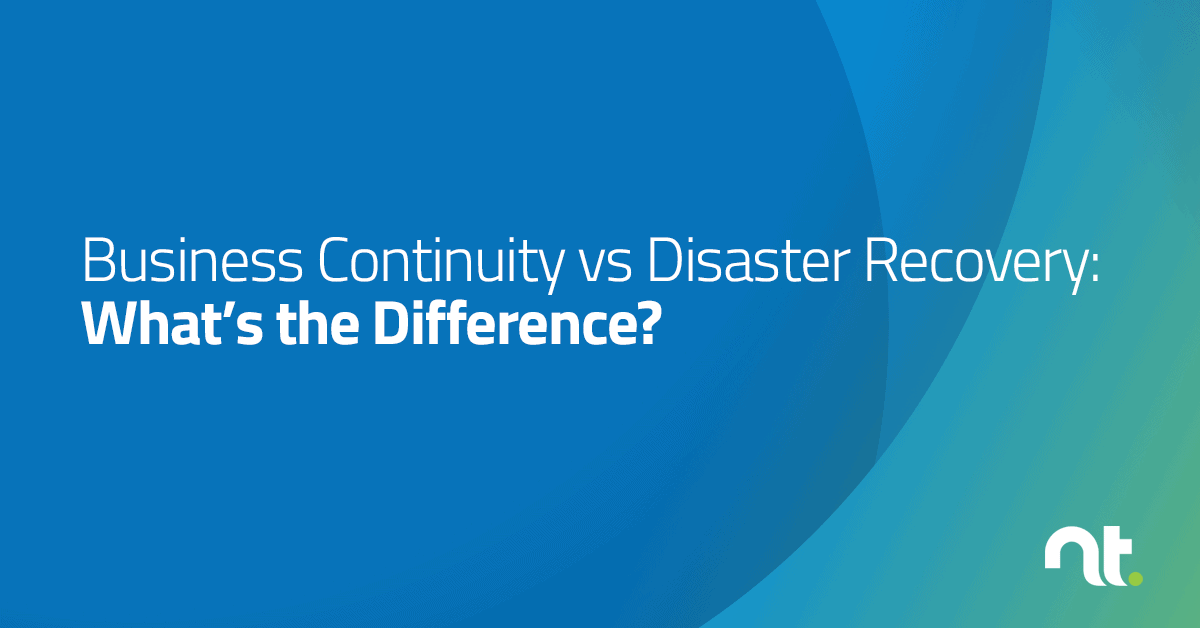- September 2, 2020
Business Continuity vs Disaster Recovery: What’s the Difference?
When it comes to businesses experiencing unexpected downtime, it’s not a matter of “if” but “when.” The causes of downtime can take different forms, varying in severity and causes. Examples of unexpected downtime that can impact your infrastructure, data and technology include network and power outages, weather emergencies, cyber-attacks, software and equipment failures, pandemics, civil unrest, and human errors.
In 2020 alone, the U.S. has experienced wildfires, rolling power outages, hurricanes, and mandatory office shutdowns due to COVID-19. Not to mention the increase in cyber security threats, due to hackers exploiting the vulnerability of businesses with newly deployed remote workforces. Companies that are not prepared for unexpected events can experience significant losses during downtime…and, unfortunately, there are businesses that never recover.
But the good news is that there are options available to minimize, or even eliminate, business downtime due to disasters and other perils! When you plan for and implement a business continuity plan and disaster recovery solutions, your business is better prepared when disasters strike.
- What exactly is a Business Continuity Plan and applicable solutions?
- What are Disaster Recovery solutions?
- How do they work together?
- Do you need one, or both?
The two solutions are often times referred to interchangeably, however they serve different purposes during a disaster. Let’s review their differences and why they’re important for businesses to implement:
What is a Business Continuity Plan (BCP)?
A set of processes, programs, supporting policies, techniques, guidelines, and procedures used to help an organization continue running during a disaster. They ensure a firm can continue functioning without downtime, regardless of the adverse circumstances or events. Most organizations have their BCP written, kept under “lock and key” and distributed amongst their senior leadership. Only certain members of leadership have the authority to initiate the BCP and it is regarded with the utmost seriousness if it is enacted.
What is Disaster Recovery Plan (DR Plan)?
Normally included within a Business Continuity Plan, the elements of a Disaster Recovery Plan include the required steps and enabled technologies for recovering from a disruptive event. This can include planning actions for recovering lost data, restoring infrastructure failure or other business technologies. Included is a defined listing of all the Disaster Recovery technology that is deployed and the owners of each deployment when applicable. This may include off-site replication as well as an on-premise devise to ensure redundancy. There are many solutions that also allow for an entire technology environment to be “spun up” in the cloud in the case of an on-site disaster.
How Do They Work Together?
The business continuity plan is all-encompassing with the necessary steps for a business to respond and recover from an unexpected incident or peril. The disaster recovery plan is a component of the broader BCP and is the “mitigate” and “recover” portion of the plan. To put it simply; business continuity planning provides the blueprint to help you maintain “business as usual” with processes and procedures, while disaster recovery planning focuses on the tools and solutions required for restoring your compromised technology and data.
Do You Need One, or Both?
Now that you know the difference between the two and understand how they work together, the answer becomes very clear…you need both. If you have a business continuity plan, but no disaster recovery element to your plan, you will find yourself scrambling to try and fix the technology your business relies on to operate. Without a proactive DR strategy in place, it will take you longer to identify and implement a fix. The longer it takes to get your technology back up and running, the more money you’re losing and the greater the impact to your business.
Let’s flip the scenario. You have a DR strategy to quickly fix and restore your technology and data, but without a broader BC plan, how will your employees know how to continue to be productive and serve your customers until the fix implemented? Without a BC plan, you can’t proactively manage your teams to make sure your organization can maintain service, consistency, and recover in the event of a disaster.
NexusTek Business Continuity and Disaster Recovery Planning
We offer complete business continuity planning services, as well as products designed and customized to ensure data and applications are fully restored and running when problems arise. Our disaster recovery services help protect your key business data while maintaining productivity and limiting financial losses during an outage. Our planning steps include:
- Evaluation & Consultation: NexusTek will evaluate the strengths and weaknesses of a company’s systems, its areas of vulnerability and possible threats, and identify other areas of potential risk.
- Plan Design: Based on our evaluation, NexusTek will design a business continuity and data disaster recovery plan that will be optimized for your company.
- Implementation & Testing: NexusTek will implement the plan, and formalize an ongoing testing and validation process to ensure your business continuity plans adapt to the company’s needs over time.

